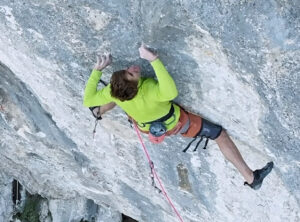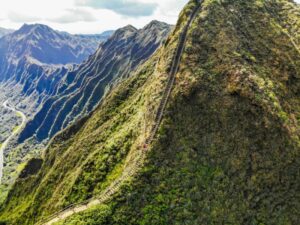One of the worst-ever mountaineering tragedies occurred not in the Himalaya or the Karakorum, but in an obscure range east of Tibet. The 1991 Kawagarbo tragedy in the Meili Snow Mountains of Yunnan, China cost 17 lives.
Kawagarbo
The Meili Snow mountain range is made up of 13 peaks, including several over 6,000m. These mountains are sacred to Buddhists. It is a pilgrimage area for thousands of devotees each year.

Gyalwa Ringnga, an imposing ridge on the west side of Meili. Photo: Edurado Martinez de Pison
The highest peak in the range is 6,740m Kawagarbo. Kawagebo means “The Sacred White Snowy Mountain”, and most locals call the entire mountain range by this name. According to local legend, Kawagarbo is the reincarnation of a dead prince who took the form of a snowy mountain formed by lightning bolts. He is a protector and warrior god, safeguarding the area’s inhabitants.
Kawagarbo is close to his beloved wife Mianzimu (6,054m). Mianzimu is considered one of the most beautiful mountains in the world. Alongside them are 6,350m Cogar Laka, 5,470m Ji Wa Ren An, and 6,509m Meili Hue Shan II, among others.
Together, these snow-capped peaks radiate the inaccessible beauty of this remote mountain range, protected by great walls of black ice near their peaks.

Mianzimu, spouse of Kawagarbo. Photo: Sebastian Alvaro
Kawagarbo and the surrounding peaks had seen previous climbing attempts by the Americans and Japanese, but no one was ever able to summit. Unfavorable weather and avalanches had turned each climb back. In 1987, a group of Japanese climbers arrived to carry out an extensive investigation of the flora, fauna, and meteorology. They donated money and materials to the local Tibetans and founded a school, but they did not climb.
A forbidden climb
In the early 1990s, they returned to the small villages at the foot of Kawagarbo. The group consisted of 11 Japanese climbers from the prestigious Joetsu Alpine Club in Kyoto, and six Chinese climbers. They had two local guides. However, no one in the village knew that the group’s true intention was to climb the holy mountain of Kawagarbo.

The Japanese-Chinese team. Photo: Min News
There are three potential routes up the mountain, each very complex. All three have to go through a different dangerous glacier. They chose a steep glacier with a flattish area about half-way down it.

The glacier on Kawagarbo. Camp1 was located on the snowy field in the middle. Photo: Min News
The team’s leader was an experienced alpine climber, 45-year-old Jiro Inoue. The rest of the group was younger, between 21 and 38 years old. Many already had experience on 8,000m mountains. The team and their local guides began to ascend the mountain.

The team. Photo: Min News
Where the shepherds stopped
At 4,500m, a stone wall is said to divide the residence of the warrior god from the rest of the world. For locals, it is a border that no human should cross. This is where shepherds would always stop, out of respect for Kawagarbo.

Tibetans turning around on the mountain.
At 3,800m, the climbers stopped, but only to take their crampons from their backpacks. They told their local guides that they wanted to climb to the top. Alarmed, the guides turned around and returned to the village to warn them.
The villagers began to pray to Kawagarbo for forgiveness. But as the hours passed, they became increasingly angry, even asking Kawagarbo to punish the intruders. The revered local lama had three visions, in which he saw the climbers crossing the limits of 4,500m, 5,500m, and 6,500m.
Meanwhile, the Chinese-Japanese team advanced. When it came time to set Camp 3, at around 5,100m, the Japanese and the Chinese had an argument. Worried about avalanches, the Japanese climbers wanted to set Camp 3 as close to the ridge as possible. This way, they could climb to the top quickly and limit their time on the mountain. The Chinese climbers wanted to be further away from the edge. Finally, they agreed to establish Camp 3 halfway between the plateau and the beginning of the ridge. This was an important decision.

A map showing the different camps. Photo: Min News
On December 28, they continued to climb, reaching Camp 4 and then up to 240m below the summit. There, a sudden change in the weather forced them to retreat back to Camp 4. They had hardly any food left, just some candy, biscuits, and sausages. However, they did not want to return home without a summit. They decided that they were going to set up a fifth camp and attack the summit on January 3, 1991. Their last contact with Base Camp was at 10:30 pm that day.

The last photo on the camera of one of the dead climbers. Photo: Min News
Searching for clues
On January 4, at around 6 am, those at Base Camp were waiting for the group to radio in. All the members had walkie-talkies, but these were turned off. The lama was worried because 17 flies had appeared on his robes, apparently an ill-omen.

One of the last photos from the camera of one of the victims. Photo: Min News
A search helicopter could not take off because of bad weather and there was no information on the terrain because no one knew the mountain above. On January 8, a Chinese team arrived to help in the search, but there was no sign of the climbers’ tents.
Finally, the helicopter managed to take off. Photos taken from the helicopter showed the remains of a gigantic avalanche, more than 300,000 tons of ice and snow.

A composite photo taken from the helicopter showed that a large avalanche had occurred. Photo: Japanese source
In April, they sent another search team, but the mountain pushed them back. They recorded a whopping 48 avalanches.
In the town at the foot of the mountain, the locals recalled a legend: Those who disrespected the god of the mountain would have one more punishment after death. They would become prisoners of the mountain for seven years.

Part of the climbing team. Photo: Min News
Seven years later, on June 18, 1998, three local shepherds found some of the group’s gear. In 1999, 4,000m away from their last known location, the bodies of 16 of the 17 climbers were found on the Ming Yong Glacier between 3,700m and 3,800m. The watch on one of the victims showed a time of 1:34 am.
A friend of the group, Kobayashi Sangli, returned almost every year to collect the climbers’ belongings from the mountain.
In 2001, China banned climbing in the Meili Snow Mountains. Kawagarbo remains unclimbed.

Kobayashi Sangli collects relics of the victims. Photo: Kobayashi Sangli






